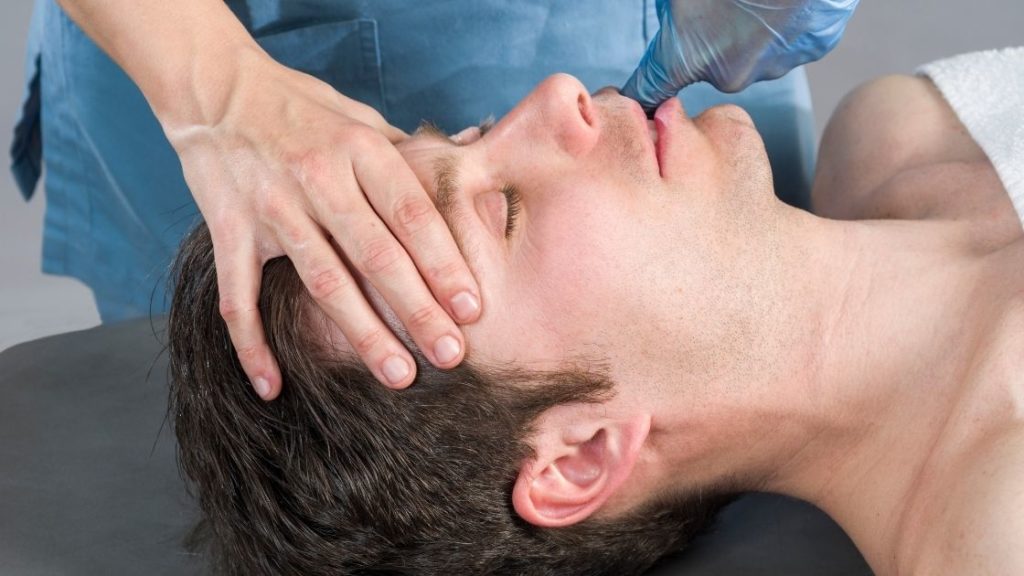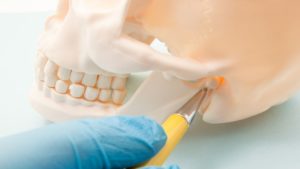Intraoral Massage: The TMJ Massage

Have you ever heard of TMJ dysfunction?
The TMJ, which is short for temporomandibular joint, is a facial joint that conjoins your temporal bone to your mandible. Or in layman terms, it connects the jawbone to the skull.
If you experience pain or reduced mobility in your jaw, you may be enduring what 10 million others in the US are enduring. The pain may be accompanied by a clicking sound when you open and close your mouth. It might be causing headaches, neck aches, and shoulder aches, too. TMJ dysfunction sounds straight up terrible, doesn’t it?
While there are many ways to treat jaw pain, intraoral massage is one of the more commonly requested types of TMJ treatment. Which is fitting, considering how effective it is!
So what does intraoral massage entail? How is it performed, and how does it relieve pain?
What to Expect During Intraoral Massage
The session will start with an assessment of your jaw. Your therapist may ask if you grind your teeth at night or if you’ve ever had a jaw injury. From there, you may be asked to move your jaw — open and close, side to side — to your full range of motion. This will help determine a possible cause of the dysfunction, the degree of impact on mobility, and which actions are triggering the pain.
It’s a given that intraoral massage is a bit invasive. Your therapist’s fingers, which are gloved and sanitary, will be touching your face and prodding your mouth. The therapist, after inserting a hooked finger into the inside of your cheek, will palpate your jaw muscles and facial bones. To get a better idea of what’s happening to your TMJ when it’s in motion, your therapist may ask you to elevate and depress your jaw during the massage.
After having the areas surrounding the TMJ massaged, the therapist may move on to massage your gums and roof of your mouth. In addition to treating jaw pain, intraoral massage also increases blood circulation in your gum tissue. Well nourished gums are healthy gums, meaning they’re less likely to encounter aches and ailments.
Since the muscles treated in intraoral massage are some of the most ignored muscles in the body, they may be a little tender. Knowing this, your therapist will start with slow and gentle pressure. Even light methodical strokes, however, may feel intense. When a muscle goes untreated for extended periods of time, sensitive spots called trigger points are more likely to arise. Have you ever had trigger point therapy? It’s not the most relaxing type of massage, as it involves some digging into those fiery little spots. But you can expect quick relief after the short bursts of pain, so don’t be scared of some intraoral trigger point therapy.
What to Expect After an Intraoral Massage
In many cases, if not most cases, an intraoral massage session won’t spend an entire 60 minutes inside your mouth and on your face. Once you feel a release in your facial muscles, your therapist will probably treat the other areas affected by jaw pain. I mentioned earlier how TMJ dysfunction can lead to headaches, neck pain, and shoulder pain in addition to jaw pain. Those muscles need help too! So right after the intraoral work, you can expect to have your scalp, neck, and shoulder muscles treated. These areas may be treated with myofascial release, trigger point therapy, assisted stretching, deep tissue, or a combination of all of them.
Now make an appointment!
At Moyer Total Wellness, we have a few very talented therapists, chiropractors, and acupuncture who specialize in intraoral massage! Give us a call to book an appointment with one of these providers so you can get your jaw back on track!

Katrina Jenkins
Author, Licensed Massage Therapist
Katrina Jenkins graduated from Towson University in 2013 with a Bachelor’s Degree in Health Science and worked as a nurse’s aide briefly before pursuing her true passion. She graduated from the Massage Therapy Institute of Colorado in April 2016 with honors and completed the Touch of Healers Scholarship Program the following summer. She has been a part of the Moyer Total Wellness Team since the summer of 2017.
Works Cited
Mayo Clinic Staff. “TMJ Disorders – Symptoms and Causes.” Mayo Clinic, 2018, www.mayoclinic.org/diseases-conditions/tmj/symptoms-causes/syc-20350941.
Pierson, Melissa Joan. “Changes in Temporomandibular Joint Dysfunction Symptoms Following Massage Therapy: A Case Report.” International Journal of Therapeutic Massage & Bodywork, vol. 4, no. 4, 31 Dec. 2011, pp. 37–47, www.ncbi.nlm.nih.gov/pmc/articles/PMC3242647/. Accessed 15 Apr. 2021.
“TMJ Disorders.” National Institute of Dental and Craniofacial Research, www.nidcr.nih.gov/sites/default/files/2017-12/tmj-disorders.pdf.
Photo Credit
Canva by Sunlight19
Canva by Shidlovski

